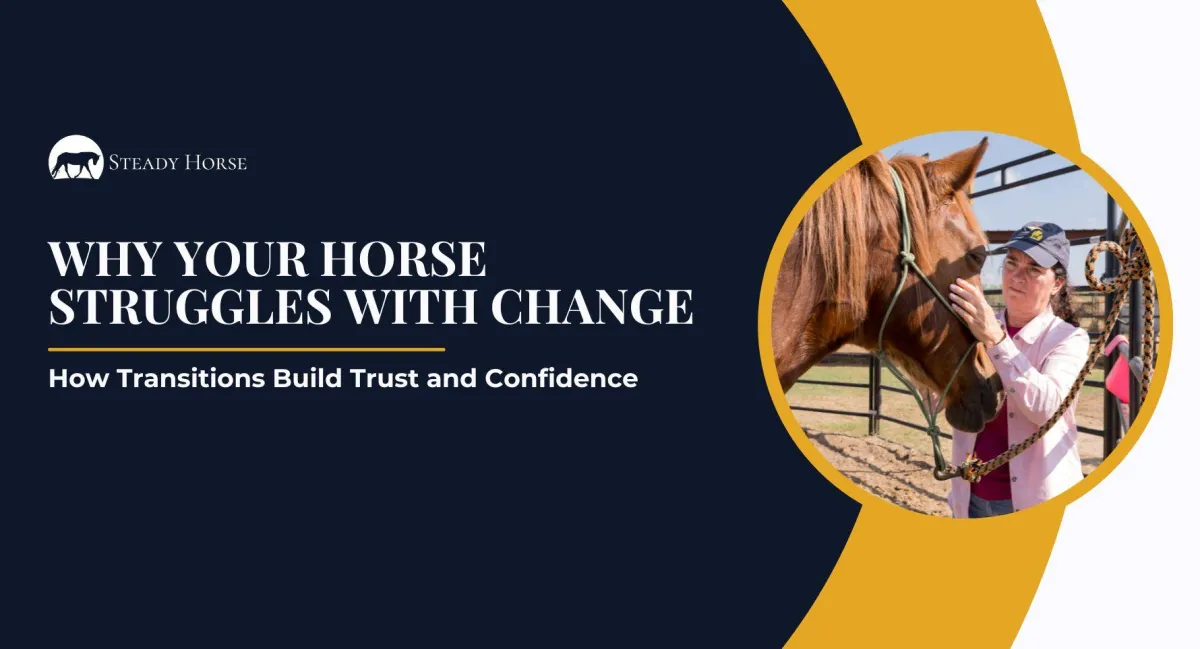
Why Your Horse Struggles with Change: How Transitions Build Trust and Confidence
If you've ever felt your horse stiffen, hesitate, or bolt during a simple change in pace or environment, you're not alone. Change—no matter how minor—can throw even experienced horses off balance emotionally and mentally. But here's the good news: transitions, when approached intentionally, are one of the most powerful tools for building confidence, deepening trust, and creating a reliable, connected partnership with your horse.
Let’s unpack what’s really going on when your horse resists change—and how to use transitions to create calm, consistent, and confident rides.
Change Isn’t the Problem—Lack of Direction Is
Horses aren’t hardwired to be comfortable with change. Their survival instincts scream “Pay attention!” the moment something shifts—whether it's a new smell, a shadow on the trail, or simply moving from a trot to a canter. The issue isn’t the change itself, it’s what the change represents: uncertainty.
When your horse senses a change and doesn't feel like someone capable is leading them through it, they try to take control. That’s when you get behaviors like spooking, balking, or rushing. They're not trying to be “bad”—they’re trying to protect themselves.
And if they don’t feel like you’ve got a plan, they’ll come up with one on their own.
What Transitions Actually Teach Your Horse
A transition is any change—whether it’s speed, direction, pressure, environment, or space. Walking into the arena from the pasture? That’s a transition. Shifting from a trot to a lope? Also a transition.
The goal isn’t just to do transitions—it’s to use them as moments of leadership and communication. When handled right, transitions reinforce two major things:
You give clear direction
You’re worth following, even in uncertainty
A smooth transition—a gentle, responsive shift—is a sign that your horse trusts you enough to follow your lead, even when the world around them is changing.
Common Signs Your Horse is Struggling with Transitions
If your horse shows any of the following behaviors, there’s likely a breakdown in how transitions are being handled:
Hesitation or stopping before entering new spaces (like gates or trailers)
Rushing through transitions (immediately breaking into a fast trot when asked to walk)
Tension in the poll or back when slowing down
Miscommunication during groundwork or saddle work
Blocking, spinning, or turning in during sending exercises
These behaviors aren’t defiance—they’re information. Your horse is telling you that change feels uncomfortable, and they need more clarity from you to feel safe.
How to Use Transitions to Build Trust and Confidence
Here’s where things shift. Instead of avoiding change or dreading those tense moments, we start leaning into them—with strategy, patience, and consistency.
1. Practice Transitions Daily—On the Ground and Under Saddle
Don’t wait until you’re out on a trail ride to practice changes. Use daily groundwork to build your horse’s comfort with transitions.
Walk ➝ Trot ➝ Walk
Back up ➝ Walk forward
Stand still ➝ Move hindquarters ➝ Stop again
Walk in the barn ➝ Pivot through a gate ➝ Pause in a new space
Every interaction is a chance to build resilience through movement.
2. Reward the Decision, Not the Motion
When a horse chooses to walk off calmly instead of rushing, reward it. When they transition down from a canter to a trot with softness, reward it. We’re not just rewarding the movement—we’re rewarding the calm, thoughtful decision to stay connected.
That’s what builds long-term confidence.
3. Don’t Rush the Process—But DO Expect Progress
You don’t need perfection right away. You do need movement toward the goal. If you try the same approach three times and see no change, something’s off—pressure, timing, clarity. Adjust. But don’t abandon the transition work just because your horse isn’t “getting it” right away.
Give them time—but don’t let confusion become the new normal.
Action Steps to Strengthen Your Transition Work
Here’s how to start shifting things today:
✅ Audit Your Horse’s Response to Everyday Changes
Do they hesitate when going from pasture to arena?
Do they rush when asked to move off?
Do they check out mentally when changing directions?
✅ Use Sending to Refine Attention
If your horse rushes during sending, don’t chase them. Draw them in. Send again. Wait for them to settle and choose calmness. That’s the moment to reward.
✅ Be Clear, Be Consistent
Your horse doesn’t need you to be perfect—they need you to be consistent. Use the same cues, the same energy, and the same rhythm. That’s what builds trust.
✅ Make the Trailer (or Any Scary Space) a Resting Place
Send around the trailer. Let them rest when they’re in it. Let them back out if they want, then go back to work outside. Over time, the trailer becomes the comfortable choice.
What Happens When You Get This Right?
You start seeing a horse that thinks during transitions instead of reacting.
The trail becomes smoother.
The arena work becomes more focused.
The groundwork becomes more intentional.
And most importantly—you and your horse grow more confident in one another.
That’s the foundation of the Unbreakable Bond.
Want a Horse That Trusts You No Matter What?
If you're ready to stop second-guessing and start building a calm, confident, unbreakable bond with your horse, it’s time to take the next step.
Through the Unbreakable Bond Elite Membership, our 1-on-1 mentorship and coaching program, you’ll get the personalized support, expert guidance, and clear plan you need to create lasting trust—on the ground, under saddle, and everywhere in between.
✅ Weekly coaching calls
✅ Step-by-step training strategies
✅ Customized roadmaps for your specific goals
✅ Private community support
Whether you’re working through transitions, trailer loading, groundwork, or riding challenges, you don’t have to figure it out alone.
👉 Schedule your free horsemanship coaching call today by clicking here.
Let’s build the bond you and your horse deserve—together.